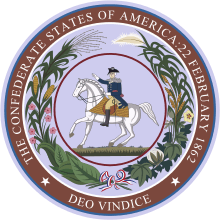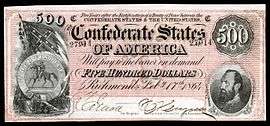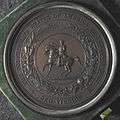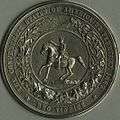Seal of the Confederate States
The Seal of the Confederate States was used to authenticate certain documents issued by the federal government of the Confederate States.[1] The phrase is used both for the physical seal itself (which was kept by the Confederate States Secretary of State), and more generally for the design impressed upon it. On May 20, 1863, C.S. Secretary of State Judah Benjamin instructed James Mason to arrange for its manufacture in London.[2] The seal was first used publicly in 1864.
| Seal of the Confederate States | |
|---|---|
 | |
| Armiger | Confederate States of America |
| Adopted | April 30, 1863 |
| Motto | Latin: Deo vindice |
| Use | on the national currency in 1864 |
Design
The Seal of the Confederate States prominently features the Statue of Washington in the capital square at Richmond.[1] In the seal, Washington is surrounded with a wreath made of some of the main agricultural products of the Confederacy: wheat, corn, tobacco, cotton, rice and sugar cane. The top margin features the words 'The Confederate States of America: 22 February 1862'. This date reflects the establishment of the federal government under the new Confederate Constitution when Jefferson Davis was inaugurated as the President of the Confederate States on Washington's birthday (February 22), 1862, in the capital square at Richmond, then the nation's capitol.[3] The bottom margin contains the national motto, Deo vindice, meaning '(With) God (as) our defender/protector'.[lower-alpha 1] C.S. Senator Thomas Semmes, in proposing the motto, took pains to stress that both the provisional and the permanent Confederate constitution "had deviated in the most emphatic manner from the spirit that presided over the construction of the Constitution of the United States, which is silent on the subject of the Deity."[4] The religious motto reflected the view of, probably, most Confederate citizens: that slavery was condoned by Christianity and thus, by extension, the Confederacy was supported by God.[5]
History

According to the Richmond Whig of September 25, 1862, a design that passed the Senate represented in the foreground a Confederate soldier, in position to charge bayonet; in the middle distance, a woman with a child in front of a church, both with hands uplifted in the attitude of prayer; for a background, a homestead in the plain, with mountains in the distance beneath the meridian sun; the whole surrounded by a wreath composed of the stalks of sugar-cane, the rice, the cotton and the tobacco plants, the margin inscribed with the words 'Seal of the Confederate States of America' above, and 'Our Homes and Constitutions' beneath. This seal was never used.[6]
The final design was approved on April 30, 1863,[1] and a set of embossing dies ordered from the London engraver Joseph Wyon.[7] The seal was first used publicly in 1864. The dies eventually reached Richmond before the end of the war.[4] However, due to the risks of running the Union blockade, the accompanying embossing press was only shipped as far as Bermuda.[8] The dies (crafted in silver) were thus unlikely to ever have been used in any official capacity. Both sets of artifacts initially passed through private ownership before ultimately entering museum collections.[7] The seal is kept at Richmond's American Civil War Museum.[9] The press is in the BNT Museum at the Globe Hotel, St. George's.[8]
Gallery
- Images of the Seal of the Confederate States


Notes
- The translation is open to some interpretation.
References
- Matthews, James M., ed. (1863). The Statutes at Large of the Confederate States of America, Passed at the Third Session of the First Congress; 1863. Richmond: R. M. Smith, Printer to Congress. p. 167. OL 25389078M – via Internet Archive.
- Beers, Henry Putney (1986). The Confederacy: A Guide to the Archives of the Government of the Confederate States of America. Washington, DC: NARA. pp. 7–8, 74. ISBN 0-911333-18-5. LCCN 86008362. OCLC 13425465. OL 2715333M.
- "Great Seal of the Confederacy". National Museum of American History. Retrieved June 22, 2013.
- Brock, R. A., ed. (January–December 1888). Southern Historical Society Papers. XVI. Richmond, Va. pp. 416–422. OCLC 61523496 – via Internet Archive.

- Rhea, Gordon (January 25, 2011). "Why Non-Slaveholding Southerners Fought". Civil War Trust. Civil War Trust. Archived from the original on March 21, 2011. Retrieved March 21, 2011.
It was a corollary that to attack slavery was to attack the Bible and the word of God. If the Bible expressly ordained slave holding, to oppose the practice was a sin and an insult to God's word... [S]lavery was the will of God, and those who opposed the institution – the abolitionists – were by definition anti-God.
- Preble, George Henry (1880). History of the flag of the United States of America, and of the naval and yacht-club signals, seals, and arms, and principal national songs of the United States, with a chronicle of the symbols, standards, banners, and flags of ancient and modern nations (2nd Revised ed.). Boston: A. Williams and Company. p. 525. LCCN war09000098. OCLC 551167. OL 29991M. Retrieved December 29, 2019 – via Internet Archive.

- Sigillologia. Being Some Account of the Great or Broad Seal of the Confederate States of America. A Monograph. Washington, D.C.: Kervand & Towers. 1873. pp. 8-11. LCCN 10019533. OL 25400537M – via Internet Archive.
- The Bermuda National Trust Museum at the Globe Hotel: Teacher Resource Guide (PDF). Bermuda National Trust. 2014. p. 16.
- "Great Seal of the Confederacy". American Civil War Museum. Retrieved December 29, 2019.
Further reading
- Documentary History of the Flag and Seal of the Confederate States of America, 1861-'65. Compiled by Raphael P. Thian. Washington. 1880. OCLC 27903837 – via Internet Archive.CS1 maint: others (link)
External links
| Wikimedia Commons has media related to Seal of the Confederate States. |
_2012_(7358970704).jpg)